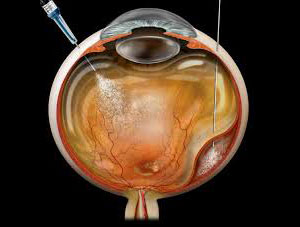- Home
- Resource Library
- Retina Resources
- Intraviteral Injection (Eye Injection)
Intraviteral Injection (Eye Injection)

WHAT ARE INTRAVITREAL INJECTIONS?
Simply put, an intravitreal injection is a procedure performed to introduce medicine directly into the gel-filled center of your eye. We know it sounds scary, but in reality, it is not, nor is it painful, something that you will realize after you’ve had it done the first time.
Intravitreal injections are used to administer a number of medicines to treat a variety of retinal conditions associated with vision loss. These include macular degeneration, diabetic retinopathy, and retinal vein occlusion, among others.
This procedure is usually performed by a retina specialist in the doctor's office.
What meds are given via eye injections?
Medications include:
- Anti-VEGF medicines used to reduce bleeding and leakage from blood vessels associated with diabetic retinopathy, macular degeneration, and retinal vein occlusion.
- Steroids may be administered to treat inflammatory conditions within your eye.
- Anti-bacterial, anti-viral, and anti-fungal medications may be delivered directly into your eye to treat infections.
How are eye injections performed? Are they painful?
Although the thought of getting a needle stuck in your eye sounds terrifying to most people, it’s a nearly painless 15-minute procedure. These injections are so common that they are performed every daily in our clinics. Once we explain the procedure, you'll find that it's really not scary.
After you are seated comfortably in our reclined procedure chair, your doctor places numbing eye drops into your eye and thoroughly cleanses your eye inside and out with a mild betadine solution.
When the numbing drops have taken effect after several minutes, an instrument will be carefully placed over your eye to hold your eyelids wide open. Your doctor may ask you to direct your gaze toward your other eye.
Next, your doctor will introduce into the gel-filled center of your eye a small dose of medicine through a syringe with a very fine needle that has the thickness of a piece of hair. You may feel slight pressure, but no pain, during the injection.
The needle is then removed and a sterile cotton swab is momentarily pressed against the tiny puncture wound to provide gentle pressure. A mild saline solution is used to irrigate and gently lubricate your eye, washing off the betadine solution that was used to clean your eye. No eye patch is needed because the eye's surface tissue seals itself off naturally.
Following your procedure, your doctor may hold up her hand and ask you to count how many fingers you can see. Or she might perform other tests. You may be sent home with antibiotic drops or lubricating ointment.
You should arrange to have transportation home, because your vision may be blurred for several hours following the injection. Some patients may notice floating dots or shadows in the eye which will fade over the next several weeks.
How will I feel after getting an eye injection?
Actually, very few patients report some soreness after the anesthesia wears off several hours following their procedure. Discomfort is usually adequately managed with Tylenol.
Few describe sensitivity and tearing or the urge to rub their eye. It's very important to avoid rubbing your eyes following this procedure because you can easily harm the surface of your eye! This is because the betadine solution used to cleanse your eye can dry your eye's surface, making it vulnerable to being easily scratched.
Your eye doctor may recommend artificial tears to help lubricate the eye. The itchiness symptoms should resolve in 2 days.
Fortunately, because your cornea is one of the fastest healing tissues in the human body, the puncture wound from your injection very rarely bleeds and is fully healed within 48 hours.
Are there any complications or risks with getting an eye injection?
Complications following an eye injection are extremely rare. In fact, the chance of having any complication following the injection of medicine into your eye is one in one thousand. A minor rare complication can be the presence of a small amount of bleeding visible in the white of your eye near the needle entry point. This usually clears up in one week.
The most serious risks following an eye injection include:
- Getting an infection inside the eye
- Inflammation within the eye
- Bleeding inside the eye's gel-filled center
- Retinal detachment
While all of these complications are treatable, they can all compromise your vision.
-
Retina Specialist
As a member of an elite group of only 3000 retina-vitreous specialists in the United States, Stanford trained Dr. Pilyugina brings to AGEI a unique skill set in the treatment and surgery of retinal disease. Her academic credentials include numerous research papers, conference presentations, medical publications, and clinical trials.














